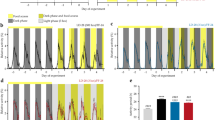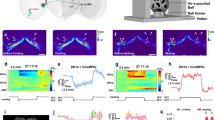Abstract
A NUMBER of environmental and pharmacological stimuli capable of inducing phase shifts and/or period changes in the circadian clock of mammals have now been identified1–3. Agents that can alter circadian clocks provide a means for investigating the cellular and neural mechanisms responsible for their generation, regulation and entrainment. Two stimuli that have been used to probe the basis of circadian rhythmicity are pulses of darkness on a background of constant light4–8and injections of short-acting benzodiazepines, such as triazolam9–11. Surprisingly, these two very different stimuli have remarkably similar phase-shifting effects on the circadian clock of hamsters. The observation that a short-term increase in locomotor activity occurs when the circadian activity rhythm of hamsters is shifted by dark pulses or triazolam injections5,6,9, coupled with the finding that activity bouts themselves are capable of shifting this rhythm12,13, raises the possibility that dark pulses or triazolam alter the circadian clock by inducing acute hyperactivity. Here we demonstrate that the phase-advancing and phase-delaying effects of dark pulses or triazolam on the circadian activity rhythm can be totally suppressed by immobilization of the animals during treatment. These results indicate that behavioural events mediate the phase-shifting effects of both dark pulses and triazolam on the circadian activity rhythm and question present hypotheses regarding the pathways by which light-dark information and pharmacological agents influence circadian pacemakers.
This is a preview of subscription content, access via your institution
Access options
Subscribe to this journal
Receive 51 print issues and online access
$199.00 per year
only $3.90 per issue
Buy this article
- Purchase on Springer Link
- Instant access to full article PDF
Prices may be subject to local taxes which are calculated during checkout
Similar content being viewed by others
References
Turek, F. W. Trends pharm. Sci. 8, 212–217 (1987).
Wirz-Justice, A. Prog. Neurobiol. 29, 219–259 (1987).
Duncan, W. C. & Wehr, T. A. in A. Rev. Chronopharmacol. 4 (eds Reinberg, A. et al.) 137–170 (Pergamon, Oxford, 1988).
Subbaraj, R. & Chandrashekaran, M. K. J. comp. Physiol. 127, 239–243 (1978).
Boulos, Z. & Rusak, B. J. comp. Physiol. 146, 239–243 (1982).
Ellis, G. B., McKlveen, R. E. & Turek, F. W. Am. J. Physiol. 242, R44–R50 (1982).
Lees, J. G., Hallonquist, J. D. & Mrosovsky, N. J. comp. Physiol. 153, 123–132 (1983).
Harrington, M. E. & Rusak, B. J. biol. Rhythms 1, 309–325 (1986).
Turek, F. W. & Losee-Olson, S. Nature 321, 167–168 (1986).
Turek, F. W. & Van Reeth, O. Trends Neurosci. 11, 535–541 (1988).
Van Reeth, O. & Turek, F. W. Am. J. Physiol. (in the press).
Mrosovsky, N. J. comp. Physiol. 162, 35–46 (1988).
Mrosovsky, N. & Salmon, P. A. Nature 330, 372–373 (1987).
Albers, H. E. & Ferris, G. F. Neurosci. Lett. 50, 163–168 (1984).
Pickard, G. J. comp. Neurol. 211, 65–83 (1982).
Harrington, M., Nance, D. M. & Rusak, B. Brain Res. 410, 275–282 (1987).
Moore, R. Y. Fedn Proc. 42, 2783–2789 (1983).
Card, J. P. & Moore, R. Y. Neuroscience 13, 415–431 (1984).
Moore, R. Y., Gustafson, E. L. & Card, J. P. Cell Tissue Res. 236, 41–46 (1984).
Van Reeth, O., Vanderhaeghen, J. J. & Turek, F. W. Brain Res. 444, 333–339 (1988).
Ralph, M. R. & Menaker, M. Brain Res. 325, 362–365 (1985).
Ralph, M. R. & Menaker, M. Brain Res. 372, 405–408 (1986).
Johnson, R. F., Smale, L., Moore, R. Y. & Morin, L. P. Proc. natn. Acad. Sci. U.S.A. 85, 5301–5304 (1988).
Moore-Ede, M., Czeisler, C. A. & Richardson, G. S. New Engl. J. Med. 309, 530–536 (1983).
Circadian Rhythms in Psychiatry (eds Wehr, T. A. & Goodwin, F. K.) (Boxwood, California, 1983).
Van Cauter, E. & Turek, F. W. Perspectives Biol. Med. 29, 510–519 (1986).
Hallonquist, J. D., Goldberg, M. A. & Brandes, J. S. Can. J. Psychiatry 31, 259–272 (1986).
Wever, R. A. The Circadian System of Man (Springer, New York, 1983).
Author information
Authors and Affiliations
Rights and permissions
About this article
Cite this article
Reeth, O., Turek, F. Stimulated activity mediates phase shifts in the hamster circadian clock induced by dark pulses or benzodiazepines. Nature 339, 49–51 (1989). https://doi.org/10.1038/339049a0
Received:
Accepted:
Issue Date:
DOI: https://doi.org/10.1038/339049a0
Comments
By submitting a comment you agree to abide by our Terms and Community Guidelines. If you find something abusive or that does not comply with our terms or guidelines please flag it as inappropriate.



